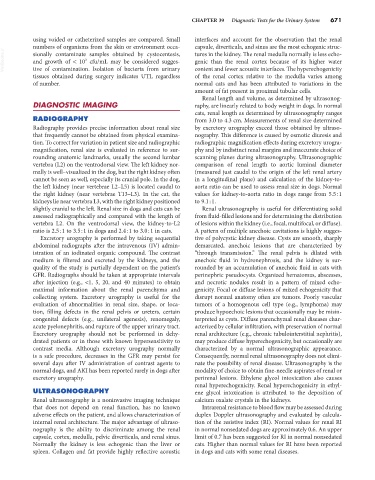Page 699 - Small Animal Internal Medicine, 6th Edition
P. 699
CHAPTER 39 Diagnostic Tests for the Urinary System 671
using voided or catheterized samples are compared. Small interfaces and account for the observation that the renal
numbers of organisms from the skin or environment occa- capsule, diverticula, and sinus are the most echogenic struc-
VetBooks.ir sionally contaminate samples obtained by cystocentesis, tures in the kidney. The renal medulla normally is less echo-
genic than the renal cortex because of its higher water
3
and growth of < 10 cfu/mL may be considered sugges-
tive of contamination. Isolation of bacteria from urinary
of the renal cortex relative to the medulla varies among
tissues obtained during surgery indicates UTI, regardless content and fewer acoustic interfaces. The hyperechogenicity
of number. normal cats and has been attributed to variations in the
amount of fat present in proximal tubular cells.
Renal length and volume, as determined by ultrasonog-
DIAGNOSTIC IMAGING raphy, are linearly related to body weight in dogs. In normal
cats, renal length as determined by ultrasonography ranges
RADIOGRAPHY from 3.0 to 4.3 cm. Measurements of renal size determined
Radiography provides precise information about renal size by excretory urography exceed those obtained by ultraso-
that frequently cannot be obtained from physical examina- nography. This difference is caused by osmotic diuresis and
tion. To correct for variation in patient size and radiographic radiographic magnification effects during excretory urogra-
magnification, renal size is evaluated in reference to sur- phy and by indistinct renal margins and inaccurate choice of
rounding anatomic landmarks, usually the second lumbar scanning planes during ultrasonography. Ultrasonographic
vertebra (L2) on the ventrodorsal view. The left kidney nor- comparison of renal length to aortic luminal diameter
mally is well–visualized in the dog, but the right kidney often (measured just caudal to the origin of the left renal artery
cannot be seen as well, especially its cranial pole. In the dog, in a longitudinal plane) and calculation of the kidney-to-
the left kidney (near vertebrae L2–L5) is located caudal to aorta ratio can be used to assess renal size in dogs. Normal
the right kidney (near vertebrae T13–L3). In the cat, the values for kidney-to-aorta ratio in dogs range from 5.5 : 1
kidneys lie near vertebra L3, with the right kidney positioned to 9.1 : 1.
slightly cranial to the left. Renal size in dogs and cats can be Renal ultrasonography is useful for differentiating solid
assessed radiographically and compared with the length of from fluid-filled lesions and for determining the distribution
vertebra L2. On the ventrodorsal view, the kidney-to-L2 of lesions within the kidney (i.e., focal, multifocal, or diffuse).
ratio is 2.5 : 1 to 3.5 : 1 in dogs and 2.4 : 1 to 3.0 : 1 in cats. A pattern of multiple anechoic cavitations is highly sugges-
Excretory urography is performed by taking sequential tive of polycystic kidney disease. Cysts are smooth, sharply
abdominal radiographs after the intravenous (IV) admin- demarcated, anechoic lesions that are characterized by
istration of an iodinated organic compound. The contrast “through transmission.” The renal pelvis is dilated with
medium is filtered and excreted by the kidneys, and the anechoic fluid in hydronephrosis, and the kidney is sur-
quality of the study is partially dependent on the patient’s rounded by an accumulation of anechoic fluid in cats with
GFR. Radiographs should be taken at appropriate intervals perinephric pseudocysts. Organized hematomas, abscesses,
after injection (e.g., <1, 5, 20, and 40 minutes) to obtain and necrotic nodules result in a pattern of mixed echo-
maximal information about the renal parenchyma and genicity. Focal or diffuse lesions of mixed echogenicity that
collecting system. Excretory urography is useful for the disrupt normal anatomy often are tumors. Poorly vascular
evaluation of abnormalities in renal size, shape, or loca- tumors of a homogenous cell type (e.g., lymphoma) may
tion, filling defects in the renal pelvis or ureters, certain produce hypoechoic lesions that occasionally may be misin-
congenital defects (e.g., unilateral agenesis), renomegaly, terpreted as cysts. Diffuse parenchymal renal diseases char-
acute pyelonephritis, and rupture of the upper urinary tract. acterized by cellular infiltration, with preservation of normal
Excretory urography should not be performed in dehy- renal architecture (e.g., chronic tubulointerstitial nephritis),
drated patients or in those with known hypersensitivity to may produce diffuse hyperechogenicity, but occasionally are
contrast media. Although excretory urography normally characterized by a normal ultrasonographic appearance.
is a safe procedure, decreases in the GFR may persist for Consequently, normal renal ultrasonography does not elimi-
several days after IV administration of contrast agents to nate the possibility of renal disease. Ultrasonography is the
normal dogs, and AKI has been reported rarely in dogs after modality of choice to obtain fine-needle aspirates of renal or
excretory urography. perirenal lesions. Ethylene glycol intoxication also causes
renal hyperechogenicity. Renal hyperechogenicity in ethyl-
ULTRASONOGRAPHY ene glycol intoxication is attributed to the deposition of
Renal ultrasonography is a noninvasive imaging technique calcium oxalate crystals in the kidneys.
that does not depend on renal function, has no known Intrarenal resistance to blood flow may be assessed during
adverse effects on the patient, and allows characterization of duplex Doppler ultrasonography and evaluated by calcula-
internal renal architecture. The major advantage of ultraso- tion of the resistive index (RI). Normal values for renal RI
nography is the ability to discriminate among the renal in normal nonsedated dogs are approximately 0.6. An upper
capsule, cortex, medulla, pelvic diverticula, and renal sinus. limit of 0.7 has been suggested for RI in normal nonsedated
Normally the kidney is less echogenic than the liver or cats. Higher than normal values for RI have been reported
spleen. Collagen and fat provide highly reflective acoustic in dogs and cats with some renal diseases.

